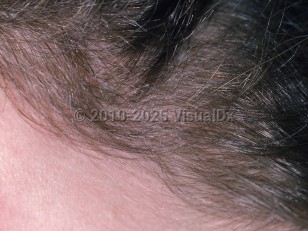Trichorrhexis nodosa - Hair and Scalp
Alerts and Notices
Important News & Links
Synopsis

Trichorrhexis nodosa (TN) is a common congenital, familial, or acquired hair shaft defect that leads to fractured and easily broken hair. It is characterized by beaded swellings (nodes) with fraying of the hair shaft cortex. The condition appears clinically as small white nodes at irregular intervals along the hair shaft. The cortical fibers splay outward and fracture, giving the node the microscopic appearance of 2 brooms or paintbrushes with their bristles thrust together. The typical expanded fracture or node precedes complete breakage.
The usual cause of TN is mechanical or chemical trauma. It is reported to occur proximally on the shaft and be related to styling practices such as straightening, perming, and hot-combing in African hair types, and distal on the hair shafts in Northern European and Asian hair types, where more mechanical trauma has occurred. Localized areas of TN may accompany foci of atopic, nummular, or contact dermatitis or lichen simplex chronicus; trichoteiromania (compulsive scalp rubbing) may present similarly.
Congenital TN may occur alone, with other minor ectodermal abnormalities, or in association with an underlying metabolic defect in the urea cycle such as argininosuccinic aciduria or citrullinemia. It may also occur with Menkes kinky hair syndrome. Inherited structural hair abnormalities associated with increased fragility are subject to TN as a secondary event (eg, trichothiodystrophy, trichorrhexis invaginata, pili torti, monilethrix, pseudomonilethrix).
Recently, a child with pili torti and TN was found to have compound heterozygous mutations in a novel ferroxidase family gene, hephaestin-like protein 1 (HEPHL1), also known as zyklopen.
Isotretinoin may cause extensive TN with subsequent progressive kinking of the hair shafts.
The usual cause of TN is mechanical or chemical trauma. It is reported to occur proximally on the shaft and be related to styling practices such as straightening, perming, and hot-combing in African hair types, and distal on the hair shafts in Northern European and Asian hair types, where more mechanical trauma has occurred. Localized areas of TN may accompany foci of atopic, nummular, or contact dermatitis or lichen simplex chronicus; trichoteiromania (compulsive scalp rubbing) may present similarly.
Congenital TN may occur alone, with other minor ectodermal abnormalities, or in association with an underlying metabolic defect in the urea cycle such as argininosuccinic aciduria or citrullinemia. It may also occur with Menkes kinky hair syndrome. Inherited structural hair abnormalities associated with increased fragility are subject to TN as a secondary event (eg, trichothiodystrophy, trichorrhexis invaginata, pili torti, monilethrix, pseudomonilethrix).
Recently, a child with pili torti and TN was found to have compound heterozygous mutations in a novel ferroxidase family gene, hephaestin-like protein 1 (HEPHL1), also known as zyklopen.
Isotretinoin may cause extensive TN with subsequent progressive kinking of the hair shafts.
Codes
ICD10CM:
L67.0 – Trichorrhexis nodosa
SNOMEDCT:
238736006 – Trichorrhexis nodosa
L67.0 – Trichorrhexis nodosa
SNOMEDCT:
238736006 – Trichorrhexis nodosa
Look For
Subscription Required
Diagnostic Pearls
Subscription Required
Differential Diagnosis & Pitfalls

To perform a comparison, select diagnoses from the classic differential
Subscription Required
Best Tests
Subscription Required
Management Pearls
Subscription Required
Therapy
Subscription Required
References
Subscription Required
Last Reviewed:03/17/2020
Last Updated:03/18/2020
Last Updated:03/18/2020
Trichorrhexis nodosa - Hair and Scalp

